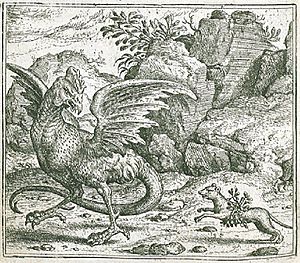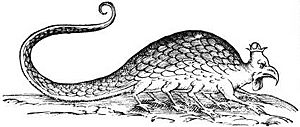Basilisk facts for kids
|
Woodblock print of a basilisk from Ulisse Aldrovandi, Serpentum, et draconum historiae libri duo, 1640
|
|
| Sub grouping | Mythological hybrids |
|---|---|
A basilisk is a scary creature from old European stories and legends. People believed it was a kind of reptile or snake that was so powerful, it was called a "serpent king." The most famous thing about a basilisk is that it could kill people just by looking at them! Its gaze was deadly.
Ancient writers like Pliny the Elder described the basilisk. He said the basilisk from Cyrene was a small snake, only about twelve inches long. But it was super venomous. It left a trail of deadly poison wherever it went. And yes, its stare could kill you.
Pliny also wrote about the basilisk's one weakness: the smell of a weasel. People would throw a weasel into the basilisk's hole. You could tell where the basilisk lived because the plants and grass around its home would be burned. Some people think the stories of the basilisk and weasel came from real-life battles between snakes (like cobras) and their enemies, the mongooses, in Asia and Africa.
What Does "Basilisk" Mean?
The word "basilisk" comes from an old Greek word, basilískos. This word means "little king" or "little prince." It was called this because some stories said it had a crown-like shape on its head. Sometimes, the basilisk was even thought to be the same creature as a cockatrice.
Stories and Legends
People in the Middle Ages in Europe started to describe the basilisk with parts of a cockerel (a male chicken). They believed it was born from a snake's or toad's egg that was hatched by a cockerel. This is the opposite of the cockatrice, which was said to hatch from a cockerel's "egg" incubated by a snake or toad.
The basilisk was always said to have a very poisonous bite. In some myths, it could even breathe fire!
One of the oldest descriptions of the basilisk comes from Pliny the Elder's book, Natural History, written around 79 AD. He wrote about a monster called the catoblepas, which could kill with its eyes. Then he said:
There is the same power also in the serpent called the basilisk. It is produced in the province of Cyrene, being not more than twelve fingers in length. It has a white spot on the head, strongly resembling a sort of a diadem. When it hisses, all the other serpents fly from it: and it does not advance its body, like the others, by a succession of folds, but moves along upright and erect upon the middle. It destroys all shrubs, not only by its contact, but those even that it has breathed upon; it burns up all the grass, too, and breaks the stones, so tremendous is its noxious influence. It was formerly a general belief that if a man on horseback killed one of these animals with a spear, the poison would run up the weapon and kill, not only the rider, but the horse, as well. To this dreadful monster the effluvium of the weasel is fatal, a thing that has been tried with success, for kings have often desired to see its body when killed; so true is it that it has pleased Nature that there should be nothing without its antidote. The animal is thrown into the hole of the basilisk, which is easily known from the soil around it being infected. The weasel destroys the basilisk by its odour, but dies itself in this struggle of nature against its own self.

Isidore of Seville, another old writer, also called the basilisk the king of snakes because of its deadly stare and poisonous breath.
Over time, people added more ways to kill a basilisk. Some legends say they could be killed by hearing a rooster crow. Others say looking at itself in a mirror would kill it. This mirror trick is part of a famous legend from Warsaw, Poland. A man supposedly killed the basilisk of Warsaw by carrying mirrors in front of him. This basilisk was said to be a mix of a rooster, snake, or turkey, with a snake's tail and frog's eyes. It guarded hidden treasures and killed anyone who came near.
Stories also said the basilisk could grow larger, breathe fire, and even kill with its voice. Some believed its breath was super toxic and caused instant death. It was even said to kill by touching something that was touching a person, like a sword. The basilisk is also a symbol of the Swiss city of Basel.
Leonardo da Vinci, the famous artist and inventor, also wrote about the basilisk. He said it was so cruel that if it couldn't kill animals with its gaze, it would turn its stare on plants and make them wither. He described it much like Pliny did, saying it was found in Cyrenaica, about 12 fingers long, and had a white spot like a crown. He also mentioned that its venom could kill a man and his horse if it ran up a spear.
In the old stories of Cantabrian mythology in Spain, the Basiliscu is rare but still exists. It's born from an egg laid by an old rooster right before it dies, at midnight on a clear full moon night. The egg has a soft, leathery shell. The creature hatches quickly, looking like an adult with legs, a beak, a cockscomb, and a reptilian body. Its eyes have an intense fire that kills any animal or person who looks directly at it. The weasel is still its only enemy. A rooster's crow can also kill it, which is why travelers used to carry roosters when going into areas where basilisks were said to live.
A basilisk was also said to have scared the people of Vilnius, Lithuania, a long time ago. A historian wrote that branches of rue, a plant believed to scare away basilisks, were lowered into its lair. The first two branches turned white, meaning the basilisk was still alive. But the third branch stayed green, showing the basilisk had finally died.
Where Did the Idea Come From?
Some people think the legends of the basilisk might have started from real-life observations of cobra snakes. Cobras can stand upright, which might have looked like the basilisk moving "upright and erect." Also, many snakes, including cobras, are hunted by mongooses, which fits the weasel part of the myth. The Indian cobra even has a crown-like mark on its head. Some types of cobras can spit venom from a distance, which could have been confused with a deadly gaze or breath. The Egyptian cobra was also a symbol of royalty in ancient Egypt.
See also
 In Spanish: Basilisco (criatura mitológica) para niños
In Spanish: Basilisco (criatura mitológica) para niños
- Basilisco Chilote
- Basiliscus (genus)
- BLIT (short story)
- Cikavac
- Cockatrice
- Colo Colo (mythology)
- Roko's basilisk
- Snallygaster
- Titanoboa
- The Book of the Dun Cow
- Harry Potter and the Chamber of Secrets
- The Owl House



